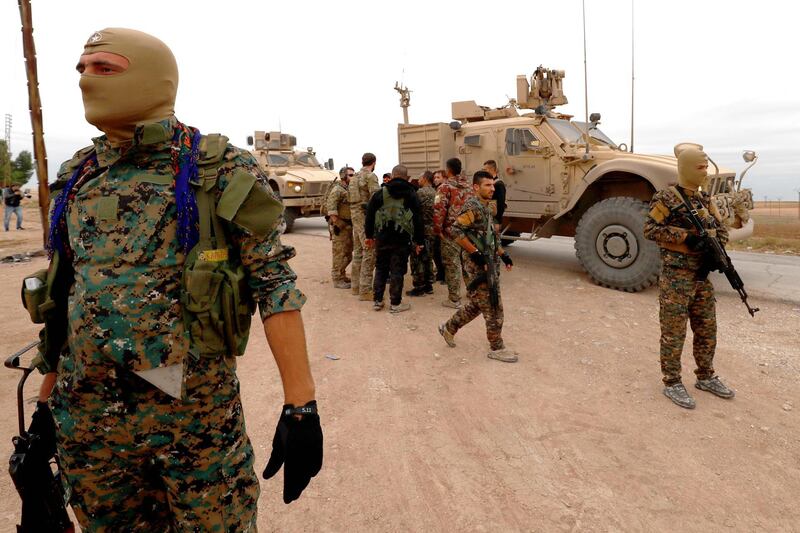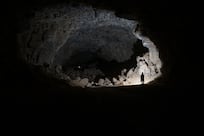Just as Henry Kissinger, the former American secretary of state, callously advocated abandoning the Kurds in 1975 to the scant mercy of Saddam Hussein, US President Donald Trump’s hastily planned withdrawal of US troops from eastern Syria again leaves its erstwhile allies to fend for themselves.
The concept of “useful Syria” became popular in 2015, when it seemed that Bashar Al Assad's regime would re-establish control over the western coastal axis with most of Syria’s population, but perhaps not beyond. But eastern Syria is far from useless. It holds all the country’s oil reserves, the Euphrates with its dams, and the Iraqi border.
It is thus a vital prize for all those contending to control it: the Kurdish-dominated Syrian Democratic Forces (SDF) and their Arab allies; the Assad regime, along with Iran, Hezbollah and Russia; Turkey; and the remnants of ISIS. The SDF has expanded from its base in the largely Kurdish Hasakah province to control a large swathe of north-eastern Syria, roughly following the Euphrates from ISIS's former capital of Raqqa down to the Iraqi border. But, militarily overstretched, it faces a challenge from the Arab populations in this area, also being solicited by the Iranians.
The various dams on the northern part of the Euphrates have several hundred megawatts of electric capacity. In July, the SDF handed over one, Tishreen, to the Syrian army in return for supplying water and power to SDF-held territory. Control of these dams either sustains or threatens not only Syria, but thirsty Iraq downstream, where water protests erupted this summer.
Along the southern reaches of the Euphrates in Syria are the oilfields of Deir Al Zor, and the Conoco gas-plant. In the north-eastern corner between Iraq and Turkey, the large heavy oil-fields of Suwaidiyah, Rumailan and others have been under Kurdish control almost since the beginning of the conflict. They produce about 50 000 barrels per day and send a third of it to the Assad-controlled refinery at Homs.
The SDF are not naive about US reliability. In August, they held talks with the Assad regime over the status of their autonomous territory. The question for them now is how to leverage their military prowess and resources, and the rivalry of their competitors. Even if the 2000 US troops appeared only a nominal force, they were a tripwire against incursions by ISIL, Assadist, Russian, Turkish or Iran-linked forces.
_____________
Read more:
[ US-backed forces battle ISIS in eastern and southeastern Syria ]
Donald Trump: US won't spend lives and dollars as Middle East policeman
Trump says ISIS defeated in Syria as US prepares exit
Political settlement possible after US leaves Syria says Russia
_______________
The US air campaign against ISIS had reduced its Syrian oil production around Deir Al Zor to about 16 000 barrels per day by late last year, and now the terrorist group it has lost control of the fields entirely. But it still retains a presence nearby and in parts of Iraq, with the potential for a resurgence which would again threaten oil infrastructure in northern Iraq.
The Assad regime is not likely to attract much international investment to rebuild the areas it has recovered. Natural resources and basic industries – oil and gas, water, phosphates around Palmyra, and the former Lafarge cement plant near Kurdish-held Kobane – are one of the few sources of money. Russian mercenaries had sought to recapture some of these sites in return for a share of the proceeds. Militias, smugglers and tribal networks will also contend over them.
Russia has far less to offer than the US. But it does have the apparent merit of consistent support for its allies, however unsavoury. Moscow is not about to control the Middle East, but by intervention in Syria, alliance with Opec, investments from the UAE, Saudi Arabia and Qatar, and engagement with Turkey, Egypt and factions in Iraq and Libya, it has become an indispensable second power. Russia wants money from the EU and others to rebuild Syria, as long as there are no strings attached for the Assad regime.
Trump’s decision to remove American forces from Syria apparently followed a call with Turkish president Recep Tayyip Erdogan. Turkey has succeeded in co-opting the autonomous Kurdistan region of Iraq, mainly through its relations with the Kurdistan Democratic Party of Masoud Barzani, building economic links through oil and construction. Dealing with the Syrian Kurds’ political organisation, the PYD, closely linked to the PKK in Turkey, considered by Ankara a terrorist organisation which threatens its territorial integrity, would be a different thing altogether. A Turkish incursion into SDF-held areas is likely but not an attempt to control them.
The planned US withdrawal from eastern Syria is generally being seen as a win for Iran. This has been the general tenor of policy under both Barack Obama and Trump. Both have sought to use sanctions to confront Iran on the field of the oil market, where victory is slow and uncertain and collateral damage to allies high, instead of in the specific regional theatres where the US complains of Tehran’s “meddling”.
Some wannabe cold-blooded Kissingerian “realists” may expect that a quagmire of the contending factions in eastern Syria will keep them at each other’s throats and distract them from challenging the US. That ignores the human cost and the potential for further waves of refugees and regional destabilisation. Assad has proved adept at manipulating jihadists against his enemies while pretending to be their essential opponent. Iran’s expeditionary strategy, Russia’s ambiguous hybrid war, and ISIS’s nihilism, all flourish in chaotic, contested settings.
Eastern Syria is key for sustaining “useful” Syria. The US never defined a clear mission for its forces beyond defeating ISIS territorially, and Trump was not going to keep them there indefinitely. But the precipitate abandonment, without any concessions by the US’s rivals, leaves eastern Syrian resources as fuel for further conflict.
Robin Mills is CEO of Qamar Energy, and author of The Myth of the Oil Crisis






